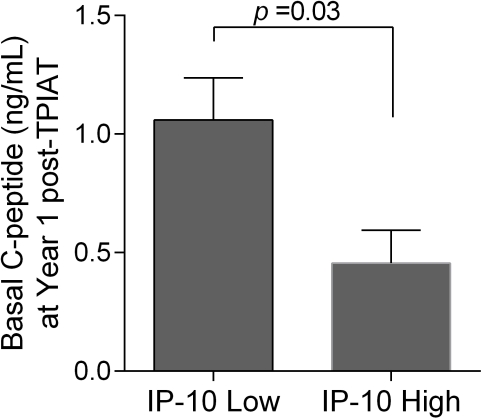Association of IP-10 With Poor Islet Graft Function After Total Pancreatectomy With Islet Autotransplantation
1Institute for Biomedical Studies, Baylor University, Waco, Tx
2Islet Cell Laboratory, Baylor Research Institute, Dallas, TX
3Baylor Annette C. and Harold C. Simmons Transplant Institute, Dallas, TX.
Meeting: 2015 American Transplant Congress
Abstract number: C190
Keywords: Inflammation, Islets, Pancreatitis
Session Information
Session Name: Poster Session C: More Controversies in Pancreas Transplantation
Session Type: Poster Session
Date: Monday, May 4, 2015
Session Time: 5:30pm-6:30pm
 Presentation Time: 5:30pm-6:30pm
Presentation Time: 5:30pm-6:30pm
Location: Exhibit Hall E
Introduction: Total pancreatectomy with islet autotransplantation (TPIAT) is an effective treatment for refractory chronic pancreatitis. The mechanisms underlying islet graft loss, however, remain unclear. Interferon gamma-induced protein (IP)-10 or CXCL10 is a chemokine which plays a central role in inflammatory diseases. We determined the role of IP-10 in islet function in autologous transplantation.
Methods: Serum samples collected from 26 TPIAT patients during 24h after islet infusion were analyzed for IP-10 using Luminex assay. Patients were divided into two groups based on high (n =11) or low (n =15) levels of post-transplant IP-10 determined by the area under the curve (AUC) after correction of islet yield (IEQ). Marginal dose of 200 islets isolated from IP-10 knockout B6 mice were transplanted into wild-type diabetic B6 mice. Graft function was determined with post-transplant blood glucose levels.
Results: Among TPIAT patients, IP-10 low group had significantly higher levels of secreted C-peptide compared to the IP-10 high group one-year post-transplant (1.1 ± 0.2 Vs 0.5 ± 0.1 ng/mL; p =0.03) (Figure). We also observed increased amount of exogenous insulin and hemoglobin A1c and decreased SUITO index in IP-10 high group compared to IP-10 low group. In the animal study, 0/6 mice in the control group showed restored normoglycemia, whereas in the mice receiving IP-10-/- islets 4/8 exhibited normoglycemia following 60 days post-transplantation. Comparison of IPGTT curves among the transplant groups showed mice receiving marginal dose of 200 IP-10-/- islets having glucose levels similar to mice receiving full dose of 400 islets from wild type mice.

Conclusions: Together, these data suggested that IP-10 secretion during the peritransplant period can result in poor glycemic control. Inhibition of IP-10, therefore, should be considered for improving islet graft function.
To cite this abstract in AMA style:
Kanak M, Lawrence M, Kunnathodi F, Yoshimatsu G, Shahbazov R, Takita M, Levy M, Naziruddin B. Association of IP-10 With Poor Islet Graft Function After Total Pancreatectomy With Islet Autotransplantation [abstract]. Am J Transplant. 2015; 15 (suppl 3). https://atcmeetingabstracts.com/abstract/association-of-ip-10-with-poor-islet-graft-function-after-total-pancreatectomy-with-islet-autotransplantation/. Accessed December 18, 2025.« Back to 2015 American Transplant Congress
